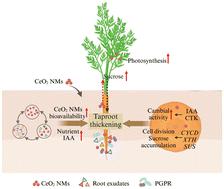当前位置:
X-MOL 学术
›
Environ. Sci.: Nano
›
论文详情
Our official English website, www.x-mol.net, welcomes your feedback! (Note: you will need to create a separate account there.)
Rhizosphere regulation with cerium oxide nanomaterials promoted carrot taproot thickening
Environmental Science: Nano ( IF 5.8 ) Pub Date : 2024-06-27 , DOI: 10.1039/d4en00334a Mengjun Zhao 1, 2 , Feiran Chen 1, 2 , Xiaona Li 1, 2 , Chuanxi Wang 1, 2 , Xuesong Cao 1, 2 , Liya Jiao 1, 2 , Le Yue 1, 2 , Zhenyu Wang 1, 2
Environmental Science: Nano ( IF 5.8 ) Pub Date : 2024-06-27 , DOI: 10.1039/d4en00334a Mengjun Zhao 1, 2 , Feiran Chen 1, 2 , Xiaona Li 1, 2 , Chuanxi Wang 1, 2 , Xuesong Cao 1, 2 , Liya Jiao 1, 2 , Le Yue 1, 2 , Zhenyu Wang 1, 2
Affiliation

|
Nanomaterials (NMs) provide great potential for sustainable development by regulating rhizosphere processes to improve crop productivity. The edible parts of rhizome crops have direct contact with the rhizosphere, which may lead to a more direct positive effect of NMs and rhizosphere interaction on the growth and development of rhizome crops. Here, 50 mg kg−1 cerium oxide (CeO2) NMs had the greatest promotion on carrot growth, and 5 days was the initial time for promoting taproot thickening. The application of CeO2 NMs to soil first stimulated the secretion of organic acids, amino acids, fatty acids, phenols, and carbohydrates (such as citric acid, asparagine, and alpha-linolenic acid), as well as growth regulators indole-3-acetic acid (IAA) and jasmonic acid, from the roots to the rhizosphere. This resulted in a significant increase in the relative abundances of Altererythrobacter, Gemmatimonas, Pseudomonas, Sphingomonas and Chryseolinea by 16.2–61.4%, thereby enhancing nutrient accumulation and elevating IAA levels in taproots. Meanwhile, CeO2 NMs were effectively absorbed by the seedling roots and transferred to the leaves. The internalized CeO2 NMs induced cell division in the taproot vascular cambium by increasing levels of IAA and cytokinins by 22.2% and 33.7%, respectively. The responsive differentially expressed genes were mainly involved in the cell wall and cell division, carbohydrate metabolism, and phytohormone signal transduction pathways. Furthermore, photosynthesis was enhanced, leading to a significant increase in sucrose and starch content by 55.3% and 71.7%, respectively. The integration of rhizobacteria, phytohormones, and gene regulations synergistically promoted carrot taproot thickening. This study contributes to our understanding of rhizosphere regulation in nano-enabled agriculture.
中文翻译:

氧化铈纳米材料的根际调节促进胡萝卜主根增厚
纳米材料(NM)通过调节根际过程来提高作物生产力,为可持续发展提供了巨大潜力。根茎作物的可食部分与根际直接接触,这可能导致NMs与根际相互作用对根茎作物的生长发育产生更直接的积极影响。其中,50 mg·kg −1 氧化铈(CeO 2 )NMs对胡萝卜生长的促进作用最大,5天是促进主根增粗的初始时间。 CeO 2 NMs 应用于土壤首先刺激有机酸、氨基酸、脂肪酸、酚类和碳水化合物(如柠檬酸、天冬酰胺和 α-亚麻酸)的分泌,以及从根到根际的生长调节剂吲哚-3-乙酸 (IAA) 和茉莉酸。这导致Altererythrobacter、Gemmatimonas、Pseudomonas、Sphingomonas和Chryseolinea的相对丰度显着增加16.2-61.4%,从而增强了养分积累并提高了主根中的IAA水平。同时,CeO 2 NMs被幼苗根部有效吸收并转移至叶片。内化的 CeO 2 NM 通过将 IAA 和细胞分裂素的水平分别增加 22.2% 和 33.7% 来诱导主根维管形成层中的细胞分裂。响应性差异表达基因主要涉及细胞壁和细胞分裂、碳水化合物代谢和植物激素信号转导途径。此外,光合作用增强,导致蔗糖和淀粉含量分别显着增加55.3%和71.7%。根际细菌、植物激素和基因调控的整合协同促进胡萝卜主根增厚。 这项研究有助于我们了解纳米农业中的根际调控。
更新日期:2024-06-27
中文翻译:

氧化铈纳米材料的根际调节促进胡萝卜主根增厚
纳米材料(NM)通过调节根际过程来提高作物生产力,为可持续发展提供了巨大潜力。根茎作物的可食部分与根际直接接触,这可能导致NMs与根际相互作用对根茎作物的生长发育产生更直接的积极影响。其中,50 mg·kg −1 氧化铈(CeO 2 )NMs对胡萝卜生长的促进作用最大,5天是促进主根增粗的初始时间。 CeO 2 NMs 应用于土壤首先刺激有机酸、氨基酸、脂肪酸、酚类和碳水化合物(如柠檬酸、天冬酰胺和 α-亚麻酸)的分泌,以及从根到根际的生长调节剂吲哚-3-乙酸 (IAA) 和茉莉酸。这导致Altererythrobacter、Gemmatimonas、Pseudomonas、Sphingomonas和Chryseolinea的相对丰度显着增加16.2-61.4%,从而增强了养分积累并提高了主根中的IAA水平。同时,CeO 2 NMs被幼苗根部有效吸收并转移至叶片。内化的 CeO 2 NM 通过将 IAA 和细胞分裂素的水平分别增加 22.2% 和 33.7% 来诱导主根维管形成层中的细胞分裂。响应性差异表达基因主要涉及细胞壁和细胞分裂、碳水化合物代谢和植物激素信号转导途径。此外,光合作用增强,导致蔗糖和淀粉含量分别显着增加55.3%和71.7%。根际细菌、植物激素和基因调控的整合协同促进胡萝卜主根增厚。 这项研究有助于我们了解纳米农业中的根际调控。











































 京公网安备 11010802027423号
京公网安备 11010802027423号